Understanding what makes a sausage "secret" requires examining both historical context and modern culinary practices. Unlike mass-produced sausages with standardized ingredients, secret sausages derive their value from undisclosed components that create distinctive flavors and textures. This tradition dates back centuries when butchers guarded their recipes as valuable trade secrets, passing them down through families or within specific communities.
The Historical Roots of Secret Sausage Recipes
The concept of secret sausages emerged from practical necessity and competitive advantage. In pre-industrial Europe, local butchers developed unique recipes using available regional ingredients, creating distinctive products that became associated with specific towns or regions. These recipes often contained:
- Regionally specific herbs and spices
- Unique meat-to-fat ratios
- Special curing or smoking techniques
- Traditional preparation methods
Many European sausage traditions, like Germany's Thüringer Rostbratwurst or France's Jambon de Bayonne, began as localized "secret" recipes before gaining protected status. These culinary traditions often contained ingredients or methods that weren't documented but passed down through generations of butchers.
| Region | Traditional "Secret" Sausage | Key Distinctive Elements |
|---|---|---|
| Germany | Thüringer Rostbratwurst | Marjoram-heavy blend, specific meat grind, protected geographical indication |
| Italy | Soppressata | Regional pepper varieties, specific aging process, meat selection |
| Spain | Chorizo de Pamplona | Unique paprika blend, garlic proportions, curing method |
| United States | Cajun Boudin | Rice content, specific herb ratios, regional variations |
Modern Interpretations of Secret Sausage Traditions
Today's artisanal sausage makers continue the tradition of proprietary blends, though the "secrets" often differ from historical practices. Contemporary secret sausages might feature:
- Innovative ingredient combinations like exotic meats or locally sourced produce
- Scientifically developed preservation techniques
- Cultural fusion recipes blending multiple culinary traditions
- Special dietary adaptations while maintaining traditional flavors
Many small-batch producers protect their recipes through non-disclosure agreements with employees and by dividing production steps among different team members. This practice ensures no single person knows the complete recipe, preserving the "secret" element that gives these products their market distinction.
Identifying Authentic Secret Sausage Products
Not all products marketed as "secret sausages" maintain genuine culinary tradition. Consumers should look for these indicators of authentic artisanal products:
- Clear indication of regional origin or producer history
- Transparency about general ingredients while protecting specific ratios
- Production methods that align with traditional techniques
- Consistent quality that demonstrates recipe refinement
Authentic secret sausages typically come from producers who can articulate their culinary heritage and demonstrate expertise in meat science. These makers often participate in food heritage organizations and maintain connections to traditional butchery practices while innovating within their craft.
Common Misconceptions About Secret Sausages
Several myths surround the concept of secret sausages that deserve clarification:
- Misconception: Secret sausages always contain unusual or mysterious ingredients
Reality: Most rely on standard ingredients in unique proportions rather than exotic components - Misconception: The "secret" refers to hidden or questionable ingredients
Reality: Reputable producers maintain full ingredient transparency within regulatory requirements - Misconception: All small-batch sausages qualify as "secret" varieties
Reality: True secret sausages represent deliberate recipe protection, not just small production scale
The most valuable secret sausages derive their distinction from generations of recipe refinement rather than mysterious components. This culinary tradition represents the intersection of food science, cultural heritage, and artisanal craftsmanship that continues to evolve in today's specialty food market.
What exactly makes a sausage qualify as a 'secret sausage'?
A sausage qualifies as 'secret' when its producer deliberately protects specific recipe elements—such as exact spice proportions, meat blends, or preparation techniques—as proprietary information. These aren't necessarily mysterious ingredients but rather carefully guarded combinations that create distinctive flavor profiles and textures distinguishing them from standard commercial products.
Are secret sausages safe to eat given the undisclosed ingredients?
Yes, authentic secret sausages are completely safe. Reputable producers must comply with all food safety regulations and ingredient labeling requirements. The 'secret' typically refers to specific proportions or preparation methods rather than undisclosed ingredients. Regulatory agencies require full disclosure of all components, though exact ratios may remain proprietary.
How can I find genuine secret sausages rather than marketing gimmicks?
Look for producers with documented culinary heritage, transparent production practices (except for the proprietary elements), and participation in food heritage organizations. Genuine secret sausages come from makers who can articulate their recipe's history and demonstrate expertise in traditional butchery techniques. Local food festivals and specialty meat markets often feature authentic artisanal producers.
Do secret sausages typically cost more than regular sausages?
Yes, authentic secret sausages generally command higher prices due to their artisanal production methods, quality ingredients, and recipe development costs. The price reflects the specialized knowledge, time-intensive preparation, and often smaller production scales required to maintain recipe integrity. However, the value comes from distinctive flavor profiles and culinary heritage that mass-produced alternatives cannot replicate.
Can I recreate secret sausage recipes at home?
While you can create excellent homemade sausages, perfectly replicating proprietary 'secret' recipes is challenging without knowing the exact proportions and techniques. Many artisanal producers develop their recipes over generations with specialized equipment. However, experimenting with different spice blends, meat combinations, and preparation methods can help you develop your own signature sausage recipes inspired by traditional techniques.











 浙公网安备
33010002000092号
浙公网安备
33010002000092号 浙B2-20120091-4
浙B2-20120091-4